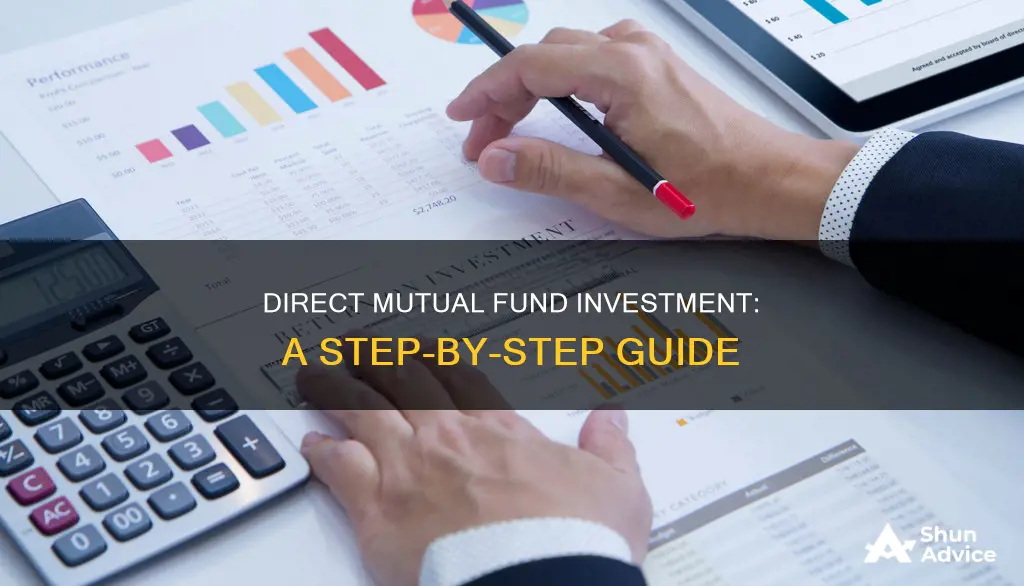
Investing in mutual funds can be done in two ways: directly or through an intermediary such as a broker or financial advisor. Direct mutual funds are purchased straight from the fund house, bypassing intermediaries and their associated fees. This results in higher returns for the investor. However, investing in direct mutual funds requires a certain level of knowledge and expertise in selecting suitable funds and managing one's portfolio.
There are two primary methods of investing in direct mutual funds: online and offline. Online investments are typically done through the fund's website, a registrar and transfer agent (RTA), or a fintech platform. Offline investments involve physically visiting the fund house or RTA office and submitting the necessary documentation.
Regardless of the method chosen, investors need to complete the Know Your Customer (KYC) process and provide essential documents, such as proof of identity, address, and income.
By understanding the process and requirements for direct mutual fund investments, individuals can take control of their financial portfolios and make informed decisions to achieve their long-term financial goals.
| Characteristics | Values |
|---|---|
| Investment options | Direct or Regular Mutual Funds |
| Direct Mutual Fund options | Online or Offline |
| Online options | Asset Management Company (AMC) website, Registrar and Transfer Agent (RTA), Mutual Fund Utilities, Investment/Robo Advisors |
| Offline options | Physical application form, visiting the fund house or RTA office |
| Requirements | KYC, PAN card, address proof, identity documents, bank account details |
| Benefits of Direct Mutual Funds | Cost savings, higher returns, no distribution commissions, ease of online transactions, flexibility and control, instant NAV, access to information, paperless transactions, no intermediary bias |
What You'll Learn

Choose a platform
When choosing a platform to make a direct investment in mutual funds, there are several options to consider. You can either opt for an online or offline approach.
Online Platforms
If you choose to invest online, you can select from the following options:
- Mutual Fund App or Website: Choose a reputable and user-friendly online mutual fund app or the fund house's website. Ensure it provides necessary information and transparency.
- Asset Management Company (AMC) Website: Visit the official website of the AMC that manages the mutual fund of your interest. You will need to create an account, complete the Know Your Customer (KYC) process, link your bank account, and then navigate to the mutual fund section to make your investment.
- Registrar and Transfer Agent (RTA): RTAs are intermediaries authorised by the Securities and Exchange Board of India (SEBI) that handle administrative tasks for mutual fund companies. They offer online platforms where you can invest in direct plans of mutual funds. Examples of RTAs include CAMS, Karvy, and Sundaram BNP Paribas.
- Mutual Fund Utilities (MFU): This is an initiative by various mutual fund houses to provide investors with a platform to invest in different schemes of participating AMCs and track their holdings and transactions in one place.
- Robo-Advisory Platforms: These are digital platforms that use algorithms to provide automated financial planning services. However, their effectiveness in solving the real-time problems of Indian investors is questionable.
Offline Platforms
If you prefer a traditional approach, you can opt for the offline method, which involves physically visiting the nearest branch or office of the selected Asset Management Company (AMC) or a local RTA office. Here, you will need to complete the KYC process if you haven't already and submit the necessary documents, such as identity and address proof, along with a mutual fund application form.
Smart Strategies for Choosing the Right Mutual Fund
You may want to see also

Register and complete KYC
Registering and completing KYC (Know Your Customer) is a crucial step in the process of making direct investments in mutual funds. Here's a detailed guide on how to go about it:
Understanding KYC:
KYC is essentially a background check performed by financial institutions to verify the identity and address of investors. It helps prevent fraud, money laundering, and other financial crimes. The Reserve Bank of India introduced the KYC guidelines for mutual funds in 2002, and it is now mandated by the Prevention of Money Laundering Act (2002).
Documents Required for KYC:
To complete the KYC process, you will need to provide the following documents:
- Proof of Identity: This can include documents such as an Aadhar Card, Voter ID Card, Passport, Driver's License, etc.
- Proof of Address: You can use documents like a bank account statement (not older than 3 months), passport, or any other valid government-issued address proof.
- PAN Card: The Permanent Account Number (PAN) card is mandatory for Mutual Fund KYC and serves as the primary identification proof.
Online KYC Registration:
You can register for KYC online through the websites of KYC Registration Agencies (KRAs). Here's a step-by-step guide:
- Visit the website of any KRA, such as CAMS, Karvy, CVL, or NDML.
- Create an account and complete the online form with your personal details, including your registered mobile number, PAN Card details, and other identification information.
- Upload self-attested documents, such as your PAN Card, Aadhar Card, and a passport-sized photograph.
- Submit the form, and the KRA will initiate the KYC verification process, often by sending an OTP to your registered mobile number.
- Once your KYC application is approved, you will receive a KYC acknowledgement or a KYC Identification Number (KIN).
Offline KYC Registration:
If you prefer, you can also complete the KYC process offline through CDSL (Central Depository Services Ltd) or with the assistance of an investment intermediary, such as banks or investment brokerages. Here's how:
- Download the MF KYC form from the CDSL website or obtain it from your chosen intermediary.
- Fill in the form, providing all the required personal details.
- Attach the necessary documents, including proof of identity, proof of address, and PAN Card copies.
- Submit the completed form along with the documents to your chosen mutual fund house or intermediary.
Additional Information:
- It is important to ensure that all the information and documents you provide are accurate and up-to-date to avoid any delays or rejections in the KYC process.
- The average time taken for online KYC registration is around 20 minutes, but this may vary depending on the mutual fund company and the method of registration.
- Remember that KYC is a mandatory process for investing in mutual funds in India, and you will not be able to participate without completing it.
By following these steps, you can register and complete your KYC, which is an essential step in making direct investments in mutual funds.
Retirement Planning: Beyond the 401(k) and Emergency Fund
You may want to see also

Link your bank account
Linking your bank account to your mutual fund account is a straightforward process, but there are a few important steps to follow to ensure smooth transactions. Here's a detailed guide on how to link your bank account for direct investment in mutual funds:
Registering Your Bank Account
When registering your bank account details with a mutual fund company, you will need to provide specific information. This typically includes the account number, type of account (savings or current), bank name, branch, city, PIN code, and IFSC code. It is essential to provide accurate information to avoid any issues with transactions.
Documents Required
To link your bank account, you will need to submit supporting documents for verification. The required documents may vary depending on the mutual fund company, but typically, you will need to provide one of the following:
- A cancelled cheque leaf with the name of the first account holder pre-printed on it.
- A bank statement reflecting the name of the account holders, account number, and address.
- A passbook page reflecting the account number, name, and address of the account holder.
Some mutual fund companies may also accept other forms of bank account verification, such as a self-attested copy of your bank statement or a bank letter certifying your account details, signed by an authorised representative of the bank.
Multiple Bank Accounts
Most mutual fund companies allow you to register multiple bank accounts, usually up to five. This can be helpful if you want to make investments from different accounts or have a backup option for transactions. However, remember that the first or sole account holder must be one of the holders of the bank account being registered.
Specifying a Default Account
When registering multiple bank accounts, you will need to specify one of them as the default or primary account. This default account will be used for systematic investment plans (SIPs), and payouts in case of redemption will also be linked to this account. You can change the default account at any time using the same form you used to register your accounts.
Using the Mutual Fund's Website or App
Some mutual fund companies offer the option to link your bank account directly through their website or mobile application. This can be a convenient way to set up your bank mandate and manage your investments.
Updating Bank Details
If you need to update your bank account details, such as changing the registered account, you will need to follow a specific process. You will typically need to fill out a form provided by the mutual fund company and submit it along with the supporting documents mentioned above. Some companies may also allow you to update your bank details through a Registrar and Transfer Agent (RTA), either by submitting the form to them or by updating your information on their website.
Cooling Period
It's important to note that if you change your bank mandate request close to submitting a redemption request, there is usually a cooling period of around ten days as a precaution against unauthorised or fraudulent transactions.
Informing the Mutual Fund Company
If you make any changes to your bank account, such as closing the account or switching to a new one, be sure to inform the mutual fund company immediately. This will help prevent any delays in payouts and ensure smooth transactions.
By following these steps, you can successfully link your bank account for direct investment in mutual funds. Remember to provide accurate information and supporting documents, and don't hesitate to contact the mutual fund company if you have any questions or concerns.
Open-Ended Mutual Funds: A Guide to Investing
You may want to see also

Explore and select funds
Once you have completed the KYC process and linked your bank account, it's time to explore the available mutual funds and select the ones that align with your financial goals, risk tolerance, and investment strategy. Here are some key factors to consider when evaluating and choosing mutual funds for your portfolio:
- Past Performance: Review the historical performance of the mutual funds. Look at their returns over different time periods to assess their consistency and identify any notable trends.
- Fund Manager Expertise: Evaluate the fund managers' experience and track record. Consider their qualifications, investment style, and success rate in generating positive returns.
- Expense Ratio: Compare the expense ratios of different mutual funds. Direct mutual funds typically have lower expense ratios than regular funds since there are no distributor commissions involved.
- Investment Strategy: Understand the investment strategy and objectives of the mutual fund. Ensure it aligns with your own investment goals and risk appetite.
- Risk Profile: Assess the risk associated with each mutual fund. Consider factors such as the volatility of the underlying assets, the diversification of the portfolio, and the potential impact of market fluctuations.
- Performance Benchmarks: Compare the performance of the mutual fund against relevant benchmarks and indices. This will help you evaluate how well the fund has performed relative to the broader market or specific industry standards.
- Fund Size and Age: Consider the size and age of the mutual fund. Larger funds may have more diversified portfolios, while younger funds might offer more growth potential but also carry higher risks.
- Fund Ratings: Research the ratings assigned to the mutual funds by reputable rating agencies. These ratings provide an independent assessment of the fund's performance, management, and overall quality.
- Fund Holdings: Analyze the holdings or portfolio composition of the mutual fund. Evaluate the quality and diversity of the underlying assets to ensure they meet your expectations and investment criteria.
- Fund Objectives: Understand the stated objectives and investment strategy of the mutual fund. Ensure that the fund's goals align with your own financial objectives, whether they are capital appreciation, income generation, or a combination of both.
It is important to thoroughly research and evaluate multiple mutual funds before making your selection. Diversifying your investments across different funds can help mitigate risks and improve your overall portfolio performance. Additionally, periodically reviewing the performance of your chosen mutual funds and making adjustments as needed is essential for optimizing your investment strategy over time.
Bond of America: State Investment Destinations
You may want to see also

Make payments and monitor
Once you have chosen the mutual fund(s) you want to invest in, you will need to make the payment. The payment methods available to you will depend on the platform you have chosen. Online platforms generally offer net banking, UPI, and debit cards as payment options. Offline, you can pay by cheque or demand draft.
After making the payment, you should receive a confirmation of your investment. This confirmation will include details such as the number of units allocated and the Net Asset Value (NAV) at which the units were purchased. You will also need to regularly check your account statements, which can be done online or mailed to your registered address.
The next step is to monitor the performance of your mutual fund investments. You may need to review and rebalance your portfolio based on changing market conditions and your financial goals. Many platforms provide tools and resources to help investors analyze their portfolios.
If you have chosen to invest offline, you can visit the fund house or registrar office for assistance or updates.
Vanguard Bond Fund: A Smart Investment Decision
You may want to see also
Frequently asked questions
You can invest in direct mutual funds either online or offline. The online method is the most convenient way, as you can save on commissions and manage multiple investments from one platform. To invest online, you must select a platform, register, complete KYC, and link your bank account. You can then explore funds and choose your investments based on your goals, risk tolerance, and investment strategy.
Direct mutual funds offer several advantages over regular mutual funds. Firstly, they have lower expense ratios because there are no distributor commissions involved. This results in cost savings and potentially higher returns for investors. Direct plans also offer increased transparency, flexibility, and control over your investment decisions, as you deal directly with the fund house.
First, visit the official website of the AMC that manages the mutual fund you're interested in. Create an account, complete the KYC process, and link your bank account. Navigate to the mutual fund section, browse through the available funds, and select the ones that align with your investment goals and risk tolerance. Specify the investment amount and type (lump sum or Systematic Investment Plan), make the payment, and you will receive a confirmation of your investment.







